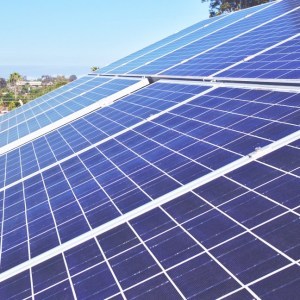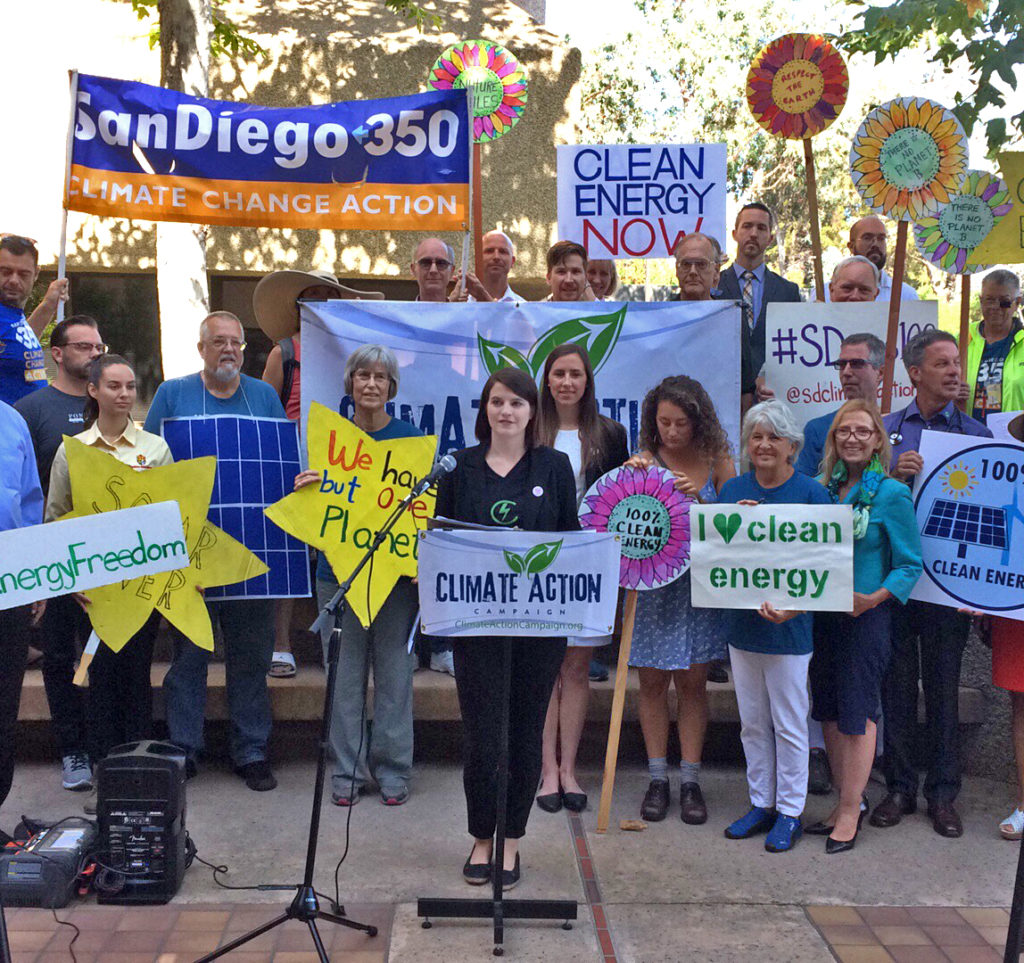
However, here in the city of San Diego, the mayor and some City Council members have been dragging their feet instead of racing ahead to get the same program up and running locally.
What is Community Choice Energy?
A Community Choice program gives customers a way to choose where their electricity comes from. A CCE is a non-profit entity which performs power procurement in competition with the for-profit utility. Electricity customers are then offered a choice between using CCE power or utility power. In either case, the utility company still delivers the electricity through their distribution system and also handles billing and customer service.
When the first CCE in the state launched in 2010, 77 percent of customers selected it as their energy provider. As people become more familiar with these programs their popularity has grown. More recently, in 2016, when the CCE Peninsula Clean Energy initiated service, 99 percent of customers selected it instead of opting to stick with utility power. Rate payers naturally gravitate to cheaper, cleaner energy. (Feasibility study | page 21)
San Diegans also want cleaner, cheaper energy, and on July 13th, when San Diego released its CCE feasibility study, they learned it was possible.
City Feasibility Study Says CCE Makes Sense for Everyone
The feasibility study announced a variety of interesting findings, most importantly, that Community Choice would lower electricity prices. San Diegans will find this as a welcome relief after years of paying SDG&E for the highest priced electricity in the state.
The study phrases it this way:
“Under the various scenarios examined, by and large the CCE program rates for most of the Study period remain below those projected for SDG&E; indicating that from ratepayers’ perspective the CCE program is beneficial.”
In fact by the 5th full year of operation, CCE electricity rates are projected to be 10% lower than SDG&E (table 23). However, price is not the only benefit listed in the study.
By providing a competing energy procurement system, the city has the ability to direct funds to local generation sources, increasing employment opportunities. According to the study:
“It is feasible that the CCA program will have a positive economic impact in terms of increased disposable income and local jobs creation.”
In addition to the economic benefits, a CCE would reduce pollution. The study based its assumptions on the city’s program initially starting out by sourcing 50 percent renewable energy for its electricity mix. That is a higher renewable percentage than is currently provided by SDG&E. State regulations require all electrical service providers in the state to supply at least 50 percent renewable energy by 2030, meaning SDG&E would eventually increase its renewable energy content.
However, the city of San Diego has determined that it wants to be far ahead of those numbers. The city, in its Climate Action Plan (CAP), has committed to 100 percent renewable energy by 2035. The CCE study found the CAP goal to be realistic and that after only five full years of CCE operation, the city could be providing up to 80 percent renewable energy at lower prices than SDG&E (Study | Figure 39, page 67).

What Are We Waiting For?
The benefits of Community Choice Energy include cleaner, cheaper energy and more jobs leading to a stronger local economy. The program is experiencing overwhelming adoption by customers everywhere it is available.
Here in San Diego, it would provide an alternative to paying SDG&E for the most expensive electricity in the state. On the other hand it would not force us into anything. In the case of Peninsula Clean Energy’s service area, for example, 1 percent of the public did decide to remain with the more expensive, dirtier energy provided by the competing utility. There truly is a choice in Community Choice Energy!
So far, I have focused on the good news out of the study, but there is one surprisingly negative piece of information referred to time and again throughout the study.
If San Diego does decide to move forward with CCE, its plan is to proceed at a snail’s pace relative to other cities across the state. The consultants preparing the study were directed to review CCE with an implementation timeline starting in 2021. At that point, it would be phased in so slowly that some customers would not gain access to the program until a year later. That is three times longer than Silicon Valley Clean Energy took to launch.
Combining the preparation and launch timeframe amounts to a five year process. That would be a California CCE record — and not in a good way. The first four California programs, which were the ones that did the heavy lifting on creating the framework for Choice programs around the state, took up to three years to form. The shortest timeline was one year.
Perhaps the best point of comparison is the City of San Jose. That city is also navigating the process of CCE formation. It is similar to San Diego in size and it also has years of experienced CCEs in the state to fall back on when making the necessary decisions. San Jose illustrates how quickly San Diego should be moving.
2016-2017: Pre-Planning/Due Diligence
2017: Formation and Development
2018: Preparation for Launch
Spring 2018: Launch
To give you a sense of the glacial pace of San Diego’s progress, the city started “pre-planning” in 2014. If San Diego was really working on getting Community Choice Energy up and running, it would have conformed to a similar schedule as San Jose’s three year timeframe. That would have meant a CCE launch early last year.
Not only did San Diego not begin CCE service in 2016, it is assuming launch for no earlier than four years from now. If the schedule doesn’t expand further, that would amount to seven years.
Accelerate the Process
For San Diego to move forward with CCE formation and launch, the City Council needs to vote to approve it. At this point, the full City Council vote on Community Choice Energy is not scheduled. The City’s Sustainable Energy Advisory Board has declared they will need months to determine if they should take the advice of the Feasibility Study. The City Council’s Environmental Committee did not even discuss CCE in their meeting after the study’s release.
The city has said that it estimates the full council vote will probably happen sometime next year. The city spent hundreds of thousands of dollars on a study to learn if CCE is the right choice and the study found that a Choice program in San Diego would give us cleaner, cheaper energy. It’s time to speed up the process.
There are a few City Council members that have been outspoken proponents of Community Choice Energy. Councilmembers David Alvarez, Barbara Bry, Chris Ward and Georgette Gomez have all proclaimed their support for CCE in San Diego.
If these are your representatives, give them a call. Let them know how excited you are that they support community choice energy and ask them to call for a full Council vote now.
The other council members and Mayor Kevin Faulconer have been a little less forthcoming regarding their opinions on a CCE program in San Diego. After the study release, the mayor made a statement saying, “We’re moving full speed ahead to reach our ultimate goal of using one hundred percent renewable energy citywide, and this draft study shows we have the ability to get there.”
It’s time to put calls in to the mayor’s office and ask him to demonstrate his stated support for CCE by requesting that the council vote, that they vote now, and that they vote in favor of Community Choice Energy.
Have you noticed the pattern? Our representatives need to hear from us to make sure that this program becomes a city priority.
Below are the names, numbers and emails – for the mayor and City Council members. If cleaner, cheaper energy in San Diego is important to you, it is time to make a call. If you want to do more, check out SanDiego350, a local environmental group working hard to make Community Choice a reality for San Diego.
City of San Diego Contact Information:
Mayor:
Kevin Faulconer, Mayor (619) 236-6330, kevinfaulconer@sandiego.gov
Councilmembers:
Myrtle Cole, Council President (619) 236-6644, myrtlecole@sandiego.gov
Mark Kersey, Council President Pro Tem (619) 236-6655, markkersey@sandiego.gov
Barbara Bry, Councilmember (619) 236-6611, barbarabry@sandiego.gov
Lorie Zapf, Councilmember (619) 236-6622, loriezapf@sandiego.gov
Christopher Ward, Councilmember (619) 236-6633, christopherward@sandiego.gov
Chris Cate, Councilmember (619) 236-6616, chriscate@sandiego.gov
Scott Sherman, Councilmember (619) 236-6677, scottsherman@sandiego.gov
David Alvarez, Councilmember (619) 236-6688, davidalvarez@sandiego.gov
Georgette Gomez, Councilmember (619) 236-6699, georgettegomez@sandiego.gov
Tyson Siegele, a SanDiego350 member, is an architect who works to promote sustainable design and clean energy. He is the creator of ButItJustMightWork.com, a residential clean energy handbook chronicling things to do as well as things to avoid on one’s path to zero emissions.
